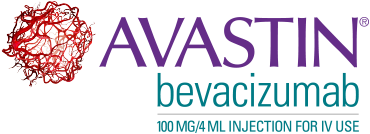Avastin® (bevacizumab), in combination with carboplatin and paclitaxel, followed by Avastin alone, is used for the treatment of patients with advanced (Stage III or IV) epithelial ovarian, fallopian tube, or primary peritoneal cancer following initial surgery.
Avastin is used with chemotherapy to treat 2 different types of recurrent ovarian cancer: platinum-sensitive and platinum-resistant.
Avastin, in combination with paclitaxel, pegylated liposomal doxorubicin or topotecan, is approved to treat platinum-resistant recurrent epithelial ovarian, fallopian tube or primary peritoneal cancer (prOC) in women who received no more than two prior chemotherapy treatments.
Avastin, either in combination with carboplatin and paclitaxel or with carboplatin and gemcitabine, followed by Avastin alone, is approved for the treatment of patients with platinum-sensitive recurrent epithelial ovarian, fallopian tube, or primary peritoneal cancer (psOC).
What is advanced (stage III or IV) ovarian cancer?
Advanced (stage III or IV) ovarian cancer is generally cancer that has not been treated with chemotherapy or other medicines before. Avastin is given after surgery along with chemotherapy for advanced ovarian cancer.
The benefits of Avastin therapy in advanced (stage III or IV) ovarian cancer
In a clinical study, Avastin, when taken with carboplatin and paclitaxel (chemotherapy) followed by Avastin alone, was shown to extend the length of time people with advanced ovarian cancer lived without their tumors growing or spreading, compared with chemotherapy alone (18.2 months vs 12.0 months).
When patients took Avastin with carboplatin and paclitaxel (chemotherapy) followed by Avastin alone instead of chemotherapy alone:

Individual results may vary.
What is the difference between platinum-sensitive and platinum-resistant cancers?
Recurrent ovarian cancer is cancer that has come back some time after first treatment with platinum-based chemotherapy. Cancer that comes back within 6 months following first treatment is called platinum-resistant, and cancer that comes back more than 6 months after initial treatment is referred to as platinum-sensitive.

The benefits of Avastin therapy in platinum-sensitive ovarian cancer
In clinical studies, when women with platinum-sensitive ovarian cancer took Avastin with chemotherapy (either in combination with carboplatin and paclitaxel or in combination with carboplatin and gemcitabine) instead of chemotherapy alone:

Individual results may vary.
The benefits of Avastin therapy in platinum-resistant ovarian cancer
In clinical studies, when women with platinum-resistant ovarian cancer took Avastin with chemotherapy (paclitaxel, pegylated liposomal doxorubicin, or topotecan) instead of chemotherapy alone:

More than 50% of patients who initially responded were still responding at: 9.4 months vs. 5.4 months.
Individual results may vary.
What are the side effects of Avastin in advanced (stage III or IV) ovarian cancer?
See the table below for common severe to life-threatening (grade 3 or 4) side effects that increased by 2% or more in patients who added Avastin to carboplatin and paclitaxel (chemotherapy) followed by Avastin alone or who added Avastin to carboplatin and paclitaxel (chemotherapy) followed by placebo compared to chemotherapy alone.

Talk to your doctor about the benefits and risks of Avastin. To learn about the possible side effects of taking Avastin, visit the Side Effects page.
What are the side effects of Avastin in psOC?
In one study, the most common severe to life-threatening side effects that increased by 2% or more in people who received Avastin plus carboplatin and gemcitabine (chemotherapy) compared to those who received placebo plus chemotherapy or vice versa (refer to the last 2 rows of the table) were:

Talk to your doctor about the benefits and risks of Avastin. To learn about the possible side effects of taking Avastin, visit the Side Effects page.
What are the side effects of Avastin in psOC?
In a separate study, the most common severe to life-threatening side effects that increased by 2% or more in people who received Avastin plus carboplatin and paclitaxel (chemotherapy) compared to those who received chemotherapy were:

Talk to your doctor about the benefits and risks of Avastin. To learn about the possible side effects of taking Avastin, visit the Side Effects page.
What are the side effects of Avastin in prOC?
The most common severe to life-threatening side effects that increased by 2% or more in people who received Avastin plus chemotherapy (compared with those receiving chemotherapy alone) were:

Talk to your doctor about the benefits and risks of Avastin. To learn about the possible side effects of taking Avastin, visit the Side Effects page.

GET FINANCIAL SUPPORT
Questions about Avastin treatment costs? Let us help you understand your financial assistance options.

FIND OUT HOW AVASTIN IS DESIGNED TO WORK
Avastin is a tumor-starving therapy. Read more about how it's designed to work.

PATIENT RESOURCES
Find helpful information and support.
